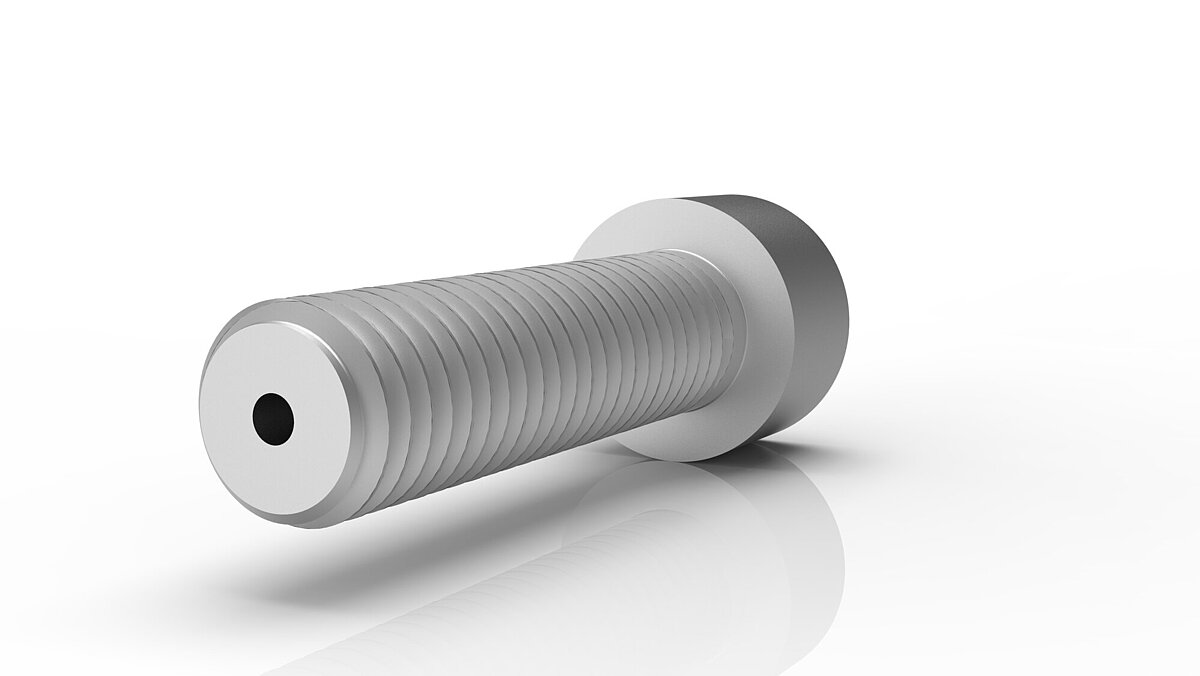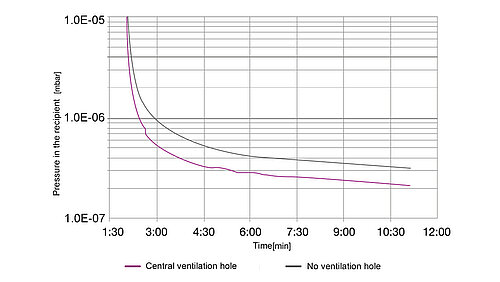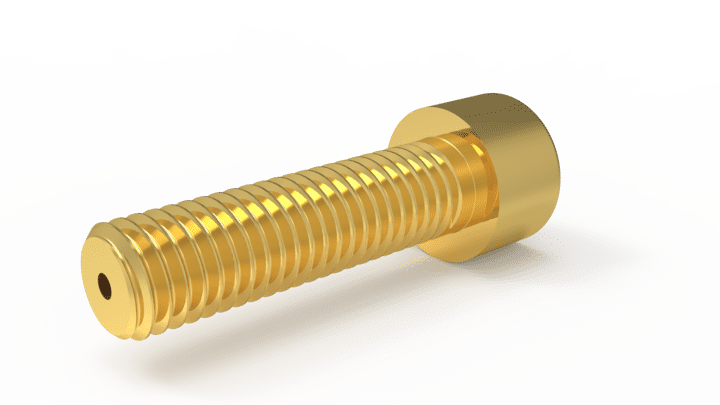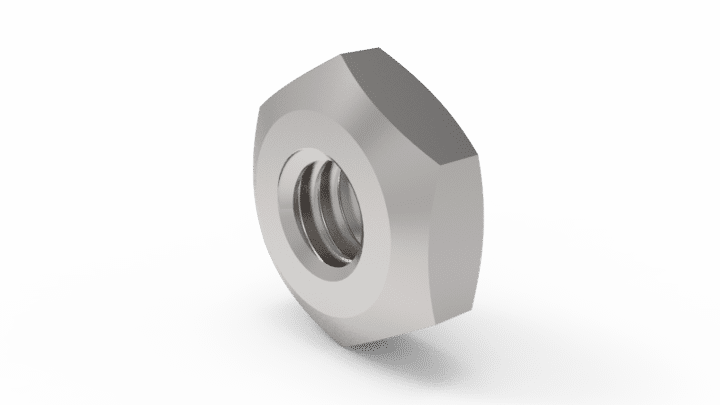From the vacuum screw to the complete vacuum chamber.
Vacuum Screws
Vacuum-compatible connecting elements are used for superstructures in vacuum systems. They are optimised and designed for low gas release. For bolted joints within a vacuum environment, the creation of "virtual leaks" and the use of lubricants or protective waxes should be avoided. Fasteners used in vacuum environments should have a high level of cleanliness and be protected from gas entrapment by venting.
Overview about vacuum screws:
- Screw variants
- Vacuum screws with low magnetic permeability
- Cleanliness requirements for screws suitable for vacuum applications
- Surface coating of vacuum screws
- Venting variants of vacuum screws
- Avoidance of virtual leaks in bolted joints by vacuum-compatible design
- Experimental investigations of virtual leaks
- Multiple use of vacuum screws
Screw variants
Materials
All fasteners available from us for use in a vacuum environment are made of stainless steel A2 strength class 70 as standard. They are cleaned for ultra-high vacuum and are packaged in a clean room environment ISO 4. In addition, cleanroom-suitable double packaging is available, which you are welcome to request from us.
Deviating materials such as A4 stainless steel, titanium, aluminium, etc. are available on request. We will be happy to advise you on the suitability of the various materials for your application. We can also manufacture special fasteners with or without coating. Please contact us for more information.
The standard material of our screws is A2 stainless steel, the "classic" chrome-nickel stainless steel 1.4301 or AISI 304. In particularly corrosive media or where a lower magnetisability is required, A4 stainless steel containing molybdenum (1.4401 or AISI 316) can be used. Titanium and aluminium are used where fasteners must not be magnetisable. In the case of aluminium, the reduced strength must be taken into account.
Shapes
Variants of the vacuum screws offered are cylinder (ISO 4762, DIN 912) and flat-head screws (ISO 7380) with hexagon socket, hexagon screws without shank (ISO 4017, DIN 933) as well as countersunk screws with hexagon socket (ISO 10642, DIN 7991) or Phillips cross recess (ISO 7046, DIN 965).
The screw sizes vary from M2 to M12.
Vacuum screws with low magnetic permeability
These screws can be used in a magnetic field without significantly deforming its field lines.
The stainless steels AISI 304 (A2) or AISI 316 (A4) are usually used for screws suitable for vacuum. The screw threads are produced by cold forming, which is the only way to achieve the required strength of 700 MPa. At the same time, however, this increases the magnetisability of the screws. In many vacuum applications such as synchrotrons, fusion reactors, in electron beam lithography or in various analytical methods such as SEM, TEM or FIB, magnetisable components can have disruptive effects. In such cases, it was previously necessary to resort to connecting elements made of special materials such as titanium. In addition to vacuum screws made of AISI 304 and AISI 316 stainless steel, VACOM also offers screws made of AISI 316L stainless steel. The composition of this special material is such that even severe cold deformation only leads to a minimal increase in magnetic permeability.
Vacuum screws made of stainless steel 316L: |
|
Cleanliness requirements for screws suitable for vacuum applications
Should unwanted impurities be present in too high concentrations, it may lead to reduced performance. The required cleanliness of fasteners is achieved by suitable ultra-fine cleaning. On an industrial scale, ultrasonic-assisted wet cleaning processes with surfactant cleaner and several rinsing stages with demineralised water have become established. In this way, the required cleanliness classes are achieved in a process-safe and verifiable manner. In vacuum technology, the surface-related outgassing rate of the components used must be below 1 ⋅ 10-9 mbar⋅l⋅s-1⋅cm-2. For UHV systems, outgassing rates lower than 1 ⋅ 10-12 mbar⋅l⋅s-1⋅cm-2 are necessary. In UCV applications, accumulated molecular contaminations with hydrocarbons of maximum 5 ⋅ 10-9 g/cm² are allowed.
| Our offer: |
|
Surface coating of vacuum screws
Coatings achieve defined and reproducible friction conditions in the bolted joint. The cleanliness requirements of vacuum technology prohibit the presence of otherwise common lubricants or protective waxes on fasteners. This leads to completely undefined friction conditions in the bolted joints and dramatically increases the risk of cold welding, seizing of the threads.
Stainless steel is the most commonly used material in vacuum technology. It is also commonly used for vacuum screws. All components of stainless steels have a low vapour pressure. The high chromium content leads to the formation of a passivation layer of chromium oxide on the surface. When making the screw connection, cracks can form in the passivation layer due to local, very high surface pressures, whereby an atomic bond is formed between the two threads. The screw is welded to the mating thread.
Screw forms and coatings
Vacuum-capable screws are provided with a silver or gold coating. They serve as a barrier between threads of the same material and reduce friction on the thread and under the screw head. The risk of cold welding of the screw connection is significantly minimised.
Venting variants of vacuum screws
Centric vent hole
Screws with centric vent holes are an established standard for preventing gas entrapment below the screw. To prevent gas entrapment under the bolt head, this type of bolt requires washers with venting notches. The centric hole causes a weakening of its cross-section, which has an effect on the mechanical load capacity, especially with small screw diameters.
Fasteners with longitudinal slot
A lateral longitudinal slot on the screws simultaneously vents the volumes below the screw and the screw head. The reduction in strength due to the change in cross-section is negligible because of the position on the outside of the bolt. The overlapping of the longitudinal slot with the threads leads to the formation of a large number of small edges, which can promote seizure of the screws. The use of vacuum screws with a longitudinal slot is therefore only recommended in a coated version.
For assemblies inside a vacuum chamber, screws are indispensable for making releasable connections. Surface roughness and shape deviations between the threads result in the smallest of gaps. The gas trapped underneath the screws and in the screw head can only escape poorly during evacuation. Such virtual leaks dramatically prolong the pump-down time of the vacuum chamber. Because of the small size of the gaps in relation to the size of the cavities (ratio 1:1000 ... 1:100000), there is a steady flow of gas from the cavities. This gas flow appears to the vacuum technician as a real pore leak. The virtual leak results in the target working pressure only being reached after a very long time or not at all.
Virtual leaks in screw connections are prevented by openings between the resulting cavities and the vacuum environment. Vacuum screws are provided with a centric vent hole or a lateral longitudinal slot along the threaded shaft and below the screw head for process-safe evacuation. The vacuum-compatible washers used have venting notches on the circular ring surface. The size of these vent holes is chosen so that there is a ratio of the order of 1:10 between the hole and the cavity. As a result, the enclosed gas already flows out of the cavities into the vacuum chamber during the evacuation phase and is pumped out with it. The performance of the vacuum system is maintained.

Experimental investigations of virtual leaks
Description
To determine the influence of virtual leaks in bolted joints on the vacuum performance of a vacuum system, tests were carried out under realistic conditions. Bolted joints were examined within a vacuum chamber. Under otherwise identical conditions, the test was carried out once with bolts without a vent hole and once with bolts that had a centric vent hole with a hole diameter of 1.8 mm.
Investigation
16 M8 x 30 mm screws were each screwed into a blind threaded hole of a test component. The test component was placed in a vacuum chamber with a well known volume and well characterised suction capacity. The vacuum chamber was evacuated and the pump down curve recorded.
Experimental survey
The pump-down curves of a vacuum chamber with 16 internal bolted joints, once without venting and once with centric venting holes on the bolts, recorded in a diagram, showed clearly visible differences in the course.

Test result
For the non-vacuum bolted joint, a "virtual leakage rate" of about 3E-7 mbar·l·s-1 was determined from the difference between the two recorded pump-down curves. In the experimental example, the pump-down time is reduced by up to 60% with a vacuum-compatible design of the bolted joints, and the base pressure achieved is 1E-7 mbar lower.
Summary: Effect of virtual leaks
Non-vacuum-compliant bolted joints have a dramatic effect on the performance of vacuum systems. Already for applications in high vacuum, bolted joints should be vacuum-compatible, in UHV technology it is absolutely essential. The determined "virtual leakage rate" of a bolted joint is enormous compared to the specified leakage rates of standardised vacuum flange joints. A bolted joint that is not designed to be vacuum-compatible generates a gas contribution that is more than 300 times greater than an elastomer O-ring-sealed flange joint and even more than 30,000 times greater than a metal-sealed UHV flange joint.
Multiple use of vacuum screws
We generally recommend replacing vacuum-compatible fasteners after one use. The repeated use of screws leads to wear on the threads. This generates particles that can be the starting point for cold welding when used again. Silver or gold coatings on screws are worn off in the heavily stressed areas during the first use. In case of further use, the protection provided by the coating is no longer guaranteed. When using vacuum screws with a coating of MoS2 or WS2, the formation of particles is unavoidable.




